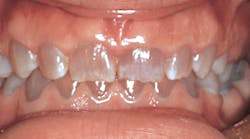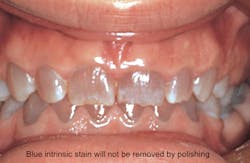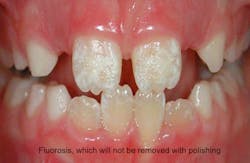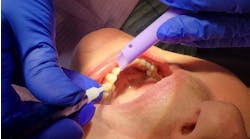Coronal polishing: Indications and contraindications for dental assistants
This article originally appeared in Dental Assisting & Office Manager Digest. Subscribe to the monthly e-newsletter here.
CORONAL POLISHING IS DEFINED AS THE PROCEDURE THAT REMOVES PLAQUE AND STAIN from the coronal surfaces of teeth. It gives the patient the “clean and sparkly” feeling and concludes many dental appointments. Many states allow dental assistants to perform this service, but in order to do so assistants might need to meet state exam, education, or credential requirements. (Look up your state requirements on the search-by-state map published on the Dental Assisting National Board Inc. [DANB] website.)
As much as patients may love to have their teeth polished, beware that there are rules to follow (if you’re wanting to be an amazing dental assistant). As the founder of SmarterDA dental assisting exam prep solution, I would like to offer a summary on coronal polishing. Use these key points as a checklist to assess whether you’re making the right choices when performing coronal polishing. If you’re studying for dental assisting boards, this is also useful for you.
Let’s start with why coronal polishing is part of the dental treatment. Polishing can:
• Create a smooth tooth surface that is less likely to retain plaque, calculus, and stain.
• Remove extrinsic stain.
• Enhance fluoride absorption and discourage the buildup of new deposits.
• Prepare teeth for various dental procedures.
ONE IMPORTANAT POINT is that coronal polishing is not a substitute for dental prophylaxis. Coronal polishing does not remove calculus. Only a thorough dental prophylaxis can remove calculus.
When do you say yes to coronal polishing? Here are the indications for coronal polishing:
• Removal of light stain.
• Removal of light plaque.
• Placement of sealants.
• Placement of dental dam.
• Placement of orthodontic bands and brackets.
• Placement of crowns and bridges.
• Removal of temporary cement residues.
• Surface cleaning before the selection of a tooth shade guide.
Here are the contraindications for coronal polishing:
• Absence of stain.
• Demineralized spots.
• Root caries.
• Gold, composite, acrylic veneers, porcelain restorations.
• Avoid reintroduction of bacteria immediately after SRP and NSPT. Polishing can be done at succeeding appointments.
• Patients with hypertension, Addison’s disease, Cushing’s syndrome, and metabolic alkalosis, as pumice can contain sodium.
• Patients with respiratory and infectious diseases,as polishing creates aerosols.
• Patients with periodontitis/gingivitis, and unhealthy, spongy, edematous tissue.
• Intrinsic stain.
• Recession with tooth sensitivity.
• Demineralizedareas or thin enamel as in amelogenesis imperfecta. Decalcified or demineralized areas appear chalky white.
• Newly-erupted teeth as the surfaces have not been fully mineralized yet.
• Teeth with large pulp chambers, such as primary teeth.
• Areas of exposed cementum and dentin.
One of the most common mistakes dental professionals make is to polish all teeth regardless of a patient’s condition. According to the list above, you may realize that you provided polishing to a pediatric patient when he or she had demineralized spots that needed the dentist’s attention first. Or maybe you polished a patient’s teeth without checking if the patient had a medical condition that can spread through aerosol. Or you may have done all the right things! Take a moment to look back at your experiences. The goal is to enhance knowledge and become the best dental professional you can be!
Selective polishing
Now that you’ve mastered when and when not to provide coronal polishing, l will explain one more concept. Have you heard the term “selective polishing”? Briefly, selective polishing means that you must carefully choose the cases and teeth for coronal polishing. With selective polishing, to continue with the example of the decalcified tooth, you can work on the other teeth and skip the ones with decalcification, or you can polish the teeth that have only visible extrinsic stain.
The judgment made by a dental assistant when polishing teeth can directly affect a patient’s oral health. If you know your indications and contraindications, you will provide better care. You may occasionally have a patient who “wants polishing at all costs.” If this happens, you’re now armed with the proper knowledge to justify your decisions.
Have a wonderful time polishing! Remember that you are a key player in the dental office, so your knowledge and actions matter. Stay #DAstrong!










